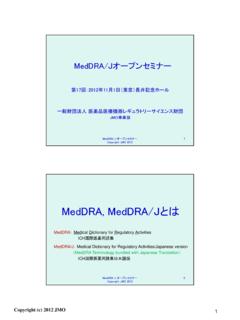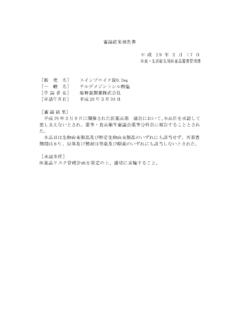Transcription of Introductory Guide for MedDRA - WHO
1 Introductory Guide MedDRA Version March 2011 Notice to Reader MedDRA Introductory Guide Version ii March 2011 Notice to Reader This Introductory Guide is written in English and is intended only for use with the English version of MedDRA . Additional Introductory Guides have been developed to support languages other than English and are included with their specific translation copies. The Introductory Guide is intended for use in conjunction with the MedDRA Browser, available with each MedDRA subscription. Changes which are version specific or changes in documentation may be found in the What s New document. This document is included with the MedDRA release and is also posted on the MSSO Web site under the Downloads section. The MedDRA terminology is maintained under an ISO 9001:2008 registered quality management system. To help readers more easily identify new and changed content within the MedDRA Introductory Guide , a list of sections with significant modifications for MedDRA Version is listed below.
2 Section Abbreviations, the following statement was added: The chemical elements are represented in MedDRA with their official chemical symbols on LLT level such as Cl for chloride and Cu for copper. Section Conventions and Exceptions: Device terms are event based, not device type based. Therefore, the MedDRA term name will generally not include the specific type of device. However, exceptions may be made for generic types of devices and device components (in widespread use) such as stents, pumps, catheters, needles, and syringes. Appendix B The following concept descriptions were added: Abuse The excessive use of a substance, especially alcohol or a drug. Device capture PT Device capturing issue refers to a situation where a device fails capture signal input or output, or captures the wrong signal input or output.
3 Acknowledgements MedDRA Introductory Guide Version iii March 2011 Acknowledgements MedDRA is a registered trademark of the International Federation of Pharmaceutical Manufacturers and Associations. Diagnostic and Statistical Manual of Mental Disorders, Fourth Edition (DSM-IV) Copyright 1994 American Psychiatric Association. ICD-9-CM, International Classification of Diseases, Ninth Revision, Clinical Modification, Copyright 1998 Medicode, Inc. COSTART Thesaurus Fifth Edition, Copyright 1995 US Food and Drug Administration (FDA). Hoechst Adverse Reaction Terminology System (HARTS), Copyright 1992 Aventis Pharma. WHO Adverse Reaction Terminology (WHO-ART), Copyright 1998 World Health Organization Collaborating Centre for International Drug Monitoring. Japanese Adverse Reaction Terminology (J-ART) is a product of the Ministry of Health, Labour and Welfare (MHLW).
4 LOINC is a registered trademark of Regenstrief Institute, Inc. Lanoxin is a registered trademark of GlaxoSmithKline. Merriam-Webster is a registered trademark of Merriam-Webster, Incorporated. Merriam-Webster Online Dictionary copyright 2005 by Merriam-Webster, Incorporated. Dorland s Illustrated Medical Dictionary, copyright 2004, W. B. Saunders, an Elsevier imprint. MedDRA Maintenance and Support Services Organization. Introductory Guide to MedDRA Version Chantilly, Virginia. March, 2011. Copyright 2011 International Federation of Pharmaceutical Manufacturers and Associations. All Rights Reserved. Table of Contents MedDRA Introductory Guide Version iv March 2011 TABLE OF CONTENTS 1. INTRODUCTION .. 1 BACKGROUND .. 1 ADOPTION OF MEDICAL TERMINOLOGY AS AN ICH TOPIC .. 2 DEVELOPMENT OF THE MEDICAL DICTIONARY FOR REGULATORY ACTIVITIES ( MedDRA ) TERMINOLOGY.
5 2 IMPLEMENTATION OF THE TERMINOLOGY .. 2 SCOPE OF THE TERMINOLOGY .. 3 INCLUSION OF TERMS FROM ESTABLISHED TERMINOLOGIES .. 4 EXCLUSION CRITERIA .. 4 2. STRUCTURAL ELEMENTS OF THE TERMINOLOGY .. 6 EQUIVALENCE .. 6 HIERARCHICAL .. 6 3. LEVELS OF STRUCTURAL HIERARCHY .. 8 LOWEST LEVEL TERMS .. 8 PREFERRED TERMS .. 9 HIGH LEVEL TERMS .. 9 HIGH LEVEL GROUP TERMS .. 9 SYSTEM ORGAN CLASS .. 10 STANDARDISED MedDRA QUERY (SMQ) .. 14 4. RULES AND CONVENTIONS ADOPTED IN THE TERMINOLOGY (INCLUDING PRESENTATION AND FORMATTING OF TERMS) .. 15 SPELLING .. 15 ABBREVIATIONS .. 15 CAPITALIZATION .. 16 PUNCTUATION .. 16 SINGLE WORD VS. MULTIPLE WORD TERMS .. 16 WORD ORDER .. 17 MedDRA CODES .. 17 BODY SITE CONSIDERATIONS IN MedDRA .. 17 Table of Contents MedDRA Introductory Guide Version v March 2011 NUMERICAL VALUES ASSOCIATED WITH PARAMETERS.
6 17 AGGRAVATION OF UNDERLYING CONDITIONS .. 18 NOS AND NEC TERMS .. 18 GENDER SPECIFIC TERMS .. 18 HIERARCHY NAMING CONVENTIONS .. 19 5. PT AND LLT NAMING CONVENTIONS .. 21 GENERAL WORD USAGE .. 21 GENERAL SEARCH STRATEGIES .. 24 6. SYSTEM ORGAN CLASSES .. 25 BLOOD AND LYMPHATIC SYSTEM DISORDERS .. 26 CARDIAC DISORDERS .. 27 CONGENITAL, FAMILIAL AND GENETIC DISORDERS .. 28 EAR AND LABYRINTH DISORDERS .. 29 ENDOCRINE DISORDERS .. 30 EYE DISORDERS .. 31 GASTROINTESTINAL DISORDERS .. 32 GENERAL DISORDERS AND ADMINISTRATION SITE 33 HEPATOBILIARY DISORDERS .. 35 IMMUNE SYSTEM DISORDERS .. 36 INFECTIONS AND INFESTATIONS .. 38 INJURY, POISONING AND PROCEDURAL COMPLICATIONS .. 40 INVESTIGATIONS .. 42 METABOLISM AND NUTRITION DISORDERS .. 47 MUSCULOSKELETAL AND CONNECTIVE TISSUE DISORDERS .. 48 NEOPLASMS BENIGN, MALIGNANT AND UNSPECIFIED (INCL CYSTS AND POLYPS).
7 49 NERVOUS SYSTEM DISORDERS .. 51 PREGNANCY, PUERPERIUM AND PERINATAL 52 PSYCHIATRIC 54 Table of Contents MedDRA Introductory Guide Version vi March 2011 RENAL AND URINARY DISORDERS .. 56 REPRODUCTIVE SYSTEM AND BREAST DISORDERS .. 57 RESPIRATORY, THORACIC AND MEDIASTINAL DISORDERS .. 58 SKIN AND SUBCUTANEOUS TISSUE DISORDERS .. 60 SOCIAL CIRCUMSTANCES .. 61 SURGICAL AND MEDICAL PROCEDURES .. 63 VASCULAR DISORDERS .. 65 APPENDIX A: ACRONYMS .. 66 APPENDIX B: MedDRA CONCEPT DESCRIPTIONS .. 69 LIST OF TABLES Table 1-1. The MedDRA Terminology Includes References to Other Terminologies .. 4 Table 3-1. The MedDRA Terminology SOC List Alphabetical Listing .. 12 Table 3-2. The MedDRA Terminology SOC List Internationally Agreed Order .. 13 LIST OF FIGURES Figure 2-1. Structural Hierarchy of the MedDRA Terminology .. 7 Introduction MedDRA Introductory Guide Version 1 March 2011 1.
8 INTRODUCTION The Medical Dictionary for Regulatory Activities ( MedDRA ) Terminology is the international medical terminology developed under the auspices of the International Conference on Harmonisation (ICH) of Technical Requirements for Registration of Pharmaceuticals for Human Use. This Guide describes the development, scope, and structure of the terminology. BACKGROUND Prior to the development of MedDRA , there had been no internationally accepted medical terminology for biopharmaceutical regulatory purposes. Most organizations processing regulatory data used one of the international adverse drug reaction terminologies in combination with morbidity terminology. In Europe, most of these organizations used a combination of the World Health Organization s Adverse Reaction Terminology (WHO-ART ) and the International Classification of Diseases Ninth Revision (ICD-9). In the United States, the Food and Drug Administration s (FDA) Coding Symbols for a Thesaurus of Adverse Reaction Terms (COSTART ) was usually used in conjunction with Clinical Modification of ICD-9 (ICD-9-CM ).
9 The Japanese developed their own versions of these international terminologies, Japanese Adverse Reaction Terminology (J-ART) and Medical Information System (Japan) (MEDIS). In addition, many organizations modified these terminologies to suit their needs. Established terminologies lacked specificity of terms at the data entry level, provided limited data retrieval options ( , too few levels in the hierarchy, or capacity to retrieve data via one axis only), and did not handle syndromes effectively. Organizations with sufficient resources developed their own in-house terminologies to address some or all of these deficiencies. The use of multiple terminologies raised several problems. Using different terminologies at various stages in a product s life complicates data retrieval and analysis, making it difficult to cross-reference data. For example, safety data had frequently been classified for pre-registration clinical trials using ICD terminology and for post-marketing surveillance using J-ART, WHO-ART, or COSTART.
10 Furthermore, using different terminologies in separate geographic regions impaired international communication and necessitated the conversion of data from one terminology to another. This data conversion had the potential to cause time delays and loss or distortion of data. In particular, these problems affected multinational pharmaceutical companies whose subsidiaries used multiple terminologies to fulfill the different data submission requirements of regulators. The use of multiple terminologies also affected communication between companies and clinical research organizations. It became increasingly difficult to manage the information required for product registration applications and to meet the time scale requirements for data exchange between regulatory authorities and the medical product industries. These difficulties prompted an industry-wide commitment to exploit developments in communication and information technology.











![01 OS MedDRAとは201103(final).ppt [互換モード]](/cache/preview/3/8/e/4/b/f/5/7/thumb-38e4bf578f48897d27e0ad38eaa72b92.jpg)



